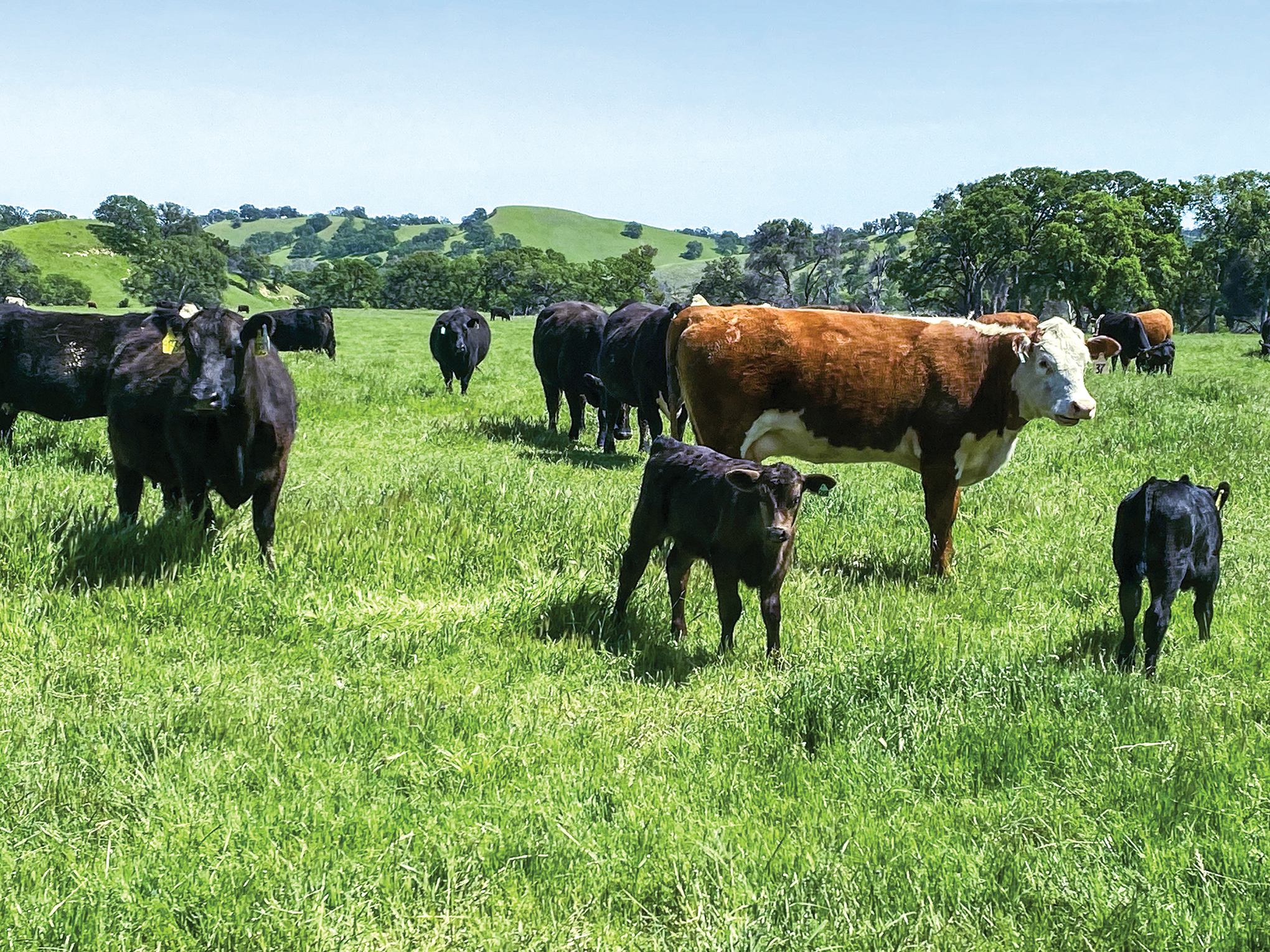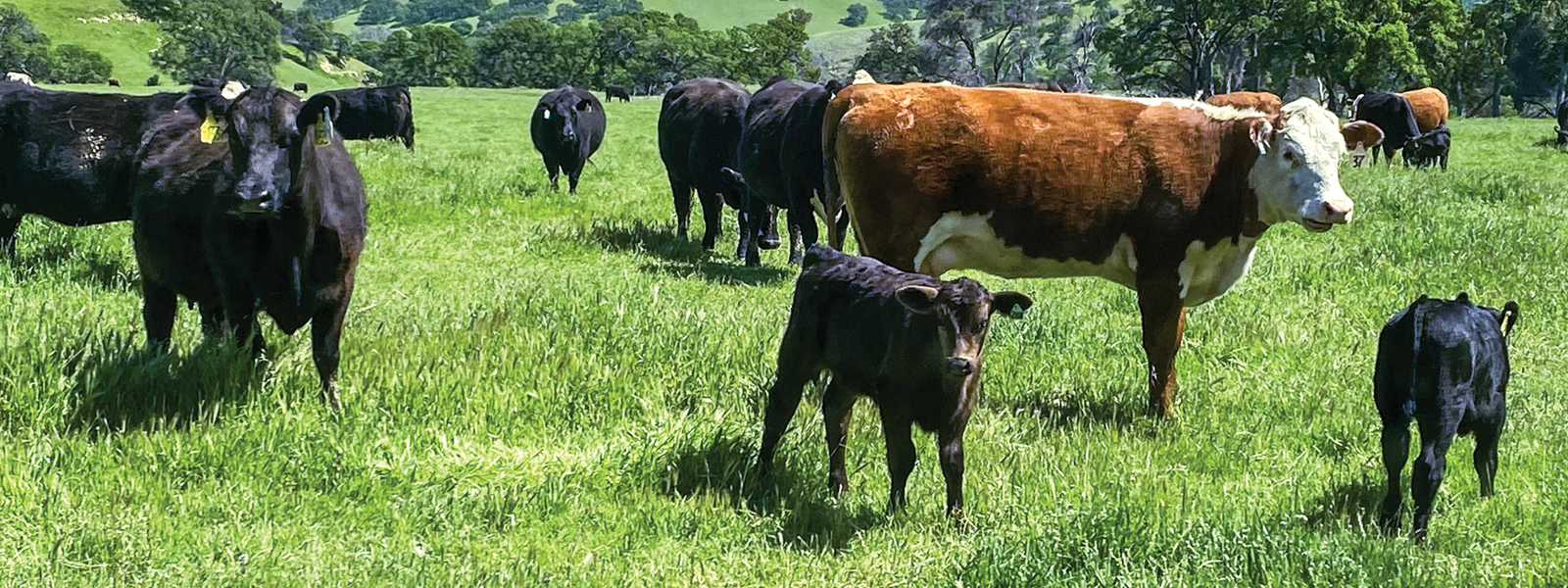Ranchers look to raise more cattle amid hot market

Cattle graze on a Yolo County ranch this spring. Flushed with forage from the wet year, California ranchers are trying to rebuild their herds after reducing them due to drought. U.S. cattle numbers remain tight, sending prices to record-high levels.
Photo/Ching Lee

By Ching Lee
Short supplies of cattle nationwide have sent prices soaring at a time when California ranchers have less to sell after years of drought forced them to shrink their herds.
With more rain and an explosion of feed on pastures this year, ranchers are eager to rebuild their numbers while the market is hot. But buying cattle at current prices may not be palatable for some.
“I’ve never seen prices this high,” said Tulare County rancher David Whaley.
Normally, Whaley would sell his heifers and use the money to buy cows that are already bred, so that he could get a calf crop in the fall and then sell those calves the following spring.
But with bred cows going for $3,000 a head, he said he decided to keep his heifers and raise them as replacements instead. This saves him money, but he won’t have calves until fall of 2024.
With a core portion of the nation’s beef herd still under severe drought conditions in the Southern Plains, cattle inventories are expected to remain tight next year, pushing prices even higher.
In its May forecast, the U.S. Department of Agriculture said it anticipates beef production in 2024 to decline 8% compared to this year, resulting in the lowest per capita beef available domestically since records began in 1970.
For now, Whaley said he’s enjoying the “feed galore” on his ranches. It’s a far cry from the past several years when dry conditions forced him to buy expensive hay and cull “extra heavy.”
With plenty of grass this year, he sold calves at around 700 pounds or more, whereas they usually weigh barely 600 pounds when he takes them to market.
“I don’t find too many things negative when I can sell seven-weight steer for over $2 a pound,” he said.
As a rancher who also operates a feedlot in Colusa County, Jerry Maltby said he thinks the cattle market will remain strong for two to three years. That’s because it takes at least two years from when a calf is born to get it to slaughter weight.
Ranchers, he said, are in “no great rush” to restock their herds if it means having to buy high-priced heifers.
He said he expects the price of bred cattle to be “substantially higher” in the fall while quality breeding females will be hard to find and very expensive for another two years.
“(Ranchers) are holding on to breeding cattle because they can see that they can make a profit by selling the offspring,” he said. “It’s not like this thing is going to change. You can’t make these cows overnight.”
With so much feed on the ground, Maltby said his feedlot business has been slower compared to the past two years when pastures were decimated by drought and ranchers had no choice but to send their cattle to feedlots.
This year, “there’s more feed than there are cattle,” he said. Not only is there an abundance of hay, but grain prices have also dropped.
Feedlot operators feel the benefits and the sting of current cattle prices, said Imperial County rancher Bill Brandenberg, who buys feeder cattle for a feedlot.
The cattle-feeding business makes good money on the cattle it sells to packers, he said, but it’s also paying record-high prices to replace the cattle.
He said he expects these conditions will continue for another two to three years because feeder cattle will remain limited until ranchers build back their herds and send more cattle through the pipeline.
“It’s a seller’s market if you’re in the cow-calf business or the dairy sector selling feeder calves because they’re in high demand right now,” Brandenberg said.
California ranchers are not the only ones keeping more of their cows this year. Ranchers in other drought-stricken states such as Utah and Colorado also have received more rain and are looking to rebuild their herds, he said. That means fewer cattle going to feedlots.
Feed costs affect the price that cow-calf producers earn for their cattle. When feed costs drop, the price of feeders rises, which has been the case during the past eight to nine months, Brandenberg said.
Gaylor Wright, owner of California Fats and Feeders in Oakdale, said he has seen a lot of bred cows coming to California from “drought country” states such as Kansas and Nebraska.
That’s because many ranchers here want to restock their herds, while those in the Midwest need to move their cattle to places with grass, especially cows that are young and well-bred.
“It’s a shame to send those to slaughter,” he said. “They’re helping us stock our grass, and we’re helping them get rid of some of their product at probably a little higher price than if they had to send it to slaughter.”
Wright’s business buys and sells cattle. He buys cattle that weigh 500 to 600 pounds, puts them in a grow yard until they’re 900 pounds and then sells them to feedlots, where they are fattened for slaughter.
With cattle so expensive now, he said he’s managed to maintain profitability by feeding byproducts such as potato chips, grape pomace and dried beans, all of which he buys at a discount. It also helps that corn and hay prices have come down.
Wright also buys slaughter-ready cattle, such as from dairies, for a Washington-based meatpacking company, which he said is not currently making money because “they can’t sell the meat as high as what it’s costing to get it.”
Meanwhile, auctions continue to move cattle at unprecedented prices, Wright said, noting some 9,000 head of fed cattle recently sold for $1.90 a pound—a record high. Even in 2014-2015, the last time cattle prices reached record levels, he noted, the fat market peaked at $1.70 a pound and then came crashing down within a week.
“How high is too high?” Wright said. “We’re getting to levels where I think people are beginning to look at other products as a potential for protein rather than beef.”
With the nationwide cattle shortage, Brandenberg of Imperial County said he expects market prices will remain higher than they’ve been over the past three to four years, but they won’t stay at the $1.80-per-pound range forever.
As long as the economy doesn’t crash, he said, prices should remain strong “because we know there’s good demand for beef.”
Consumers, he said, will ultimately determine where the market sweet spot will be. With summer grilling season starting, it’s yet to be seen at what price shoppers pull back and opt for other proteins such as pork or chicken.
“We know that consumers will switch for price,” Brandenberg said. “Then we’ve got to get our price back down to get their business back.”
(Ching Lee is an assistant editor of Ag Alert. She may be contacted at clee@cfbf.com.)




